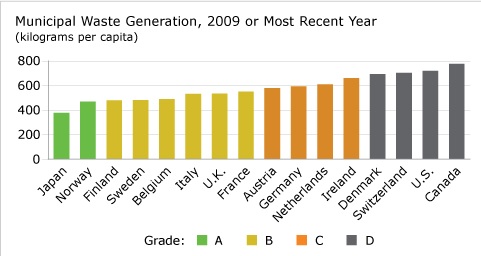Brian Isard
July 1, 2016
Now here’s an interesting fact that points to why the regulatory landscape around waste management and recycling is set to change: Using the most recent data available Canada ranks in last place out of 17 countries.

Source: Conference Board of Canada
The problem with municipal recycling is the lack of secondary markets for the recycled material and the resulting low diversion rates. Ontario, which generates 12 million tons of waste annually and diverts only 25 per cent from landfill, is set to make a significant change to their regulatory landscape that will see the cost for funding recycling program shift from the tax payer to the producer of the products or packaging being recycled. Other provinces are paying attention to how these changes play out. Quebec has been moving in this direction since 2011.
Waste and waste diversion is regulated by all three levels of government (federal, provincial, and municipal) but it is the provincial regulations that most affect our industry members.
The regulations that govern waste management and recycling are generally divided into two areas: the residential sector and the industrial, commercial and institutional sectors (IC&I). While residential waste management programs are enforced by each municipality through various programs such as curbside recycling, in the IC&I sector individual sectors are responsible for compliance with waste management regulations.
According to Statistics Canada the waste diversion rate for the non-residential sector, including the ICI and Construction, Renovation and Demolition (CRD) sectors is only 13%. (Source OWMA)
Ontario has taken a big move towards improving waste reduction and recycling rates with the recent introduction of the Waste-Free Ontario Act: An Act to enact the Resource Recovery and Circular Economy Act, 2015 and the Waste Diversion Transition Act, 2015.
The key provision in the new regulations is Extended Producer Responsibility (EPR) which will place full responsibility on producers for their products and packaging at end of life. The producer’s responsibility will extend to recovery targets, standards and reporting requirements. Producers would have the ability on how to meet these requirements whether individually or by pooling their efforts either intra or inter-provincially where producers of products and packaging will bear full responsibility.
If you study the new legislation you will find that wood packaging has been identified in Section 56 under the definition of “transport packaging” and pallets are mentioned specifically as a waste stream that will be monitored.
What does this mean for our industry, especially for Ontario which represents both the largest number of producers of wood packaging and the largest market for their products?
In talking to some of the key stakeholders in the recycling industry one of the first challenges for the government will be to gather data on the effective recycling rates on an industry by industry basis. Once they have a good understanding of the recycling rates according to industry sector they can adopt a further regulatory approach to force industries to improve their recycling rates.
Some industry sectors with low recycling rates are quite concerned while others are working hard to better define their recycling rates. These sectors, such as the CR&D sector, have been moving towards more effective source separation and collection facilities that will ensure waste reduction, value creation, and effective recycling systems.
The CR& D sector shares a common waste product with the wood packaging industry; we are both generators of wood waste.
In most jurisdictions across Canada wood products have long been banned at landfill sites but there is no effective capturing of information on just how much wood is recycled and how much is disposed of.
Although our industry can point to some impressive outcomes for recycling efforts such as the pallet pooling applications found in the grocery, hardware and beverage product distribution we have virtually no data that can be provided to regulatory agencies that will substantiate our claim that the wood packaging industry effectively recycles what it produces.
This is an area that we need to respond to. As wood packaging manufacturers we know that wood pallets are recycled and pallets at the end-of-life are re-processed into such as landscape mulch, animal bedding, soil enhancements, and wood particle board or used in bioenergy. Problem is that in Canada we can’t define volumes of wood packaging that is recycled .As an industry we need to be able to demonstrate to the regulatory agencies across the country how our industry recycles our products at end of life and provide meaningful data on our recycling efforts.
Here is an opportunity for an industry to gather data that will provide long term benefits in securing our markets for the future.